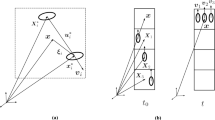Abstract
A new model of micropolar continuum composed of two-spin particles is considered. In fact, this continuum represents a two-component continuum. The first component possesses the translational and rotational degrees of freedom, whereas the second component has only the rotational degrees of freedom. The main characteristic feature of the suggested model is that both the components are not infinitesimal rigid bodies. They are the body-points of a general type, which differ from infinitesimal rigid bodies by additional inertia parameters. A continuum, composed of such particles, has some additional properties compared with a conventional material. We suggest to use the continuum of two-spin particles as a mechanical model (or, in other words, a mechanical analogy) of the electromagnetic field in matter. This model does not pretend to be an explanation of the physical nature of electromagnetic phenomena. The interpretations of the electric charge, the electric field vector, the magnetic induction vector, and other physical quantities, which are given in accordance with the suggested model, are no more than the mechanical analogies. We show that the mathematical description of our model contains two special cases. Under one simplifying assumption, the suggested equations are reduced to the equations similar to Maxwell’s equations. Under another simplifying assumption, an analogue of the Lorentz force is obtained. We believe that in some cases the exact equations describing our mechanical model can be of interest for applications in electrodynamics.
Similar content being viewed by others
References
Whittaker, E.: A History of the Theories of Aether and Electricity. The Classical Theories. Thomas Nelson and Sons Ltd, London etc. (1910)
Treugolov I.G.: Moment theory of electromagnetic effects in anisotropic solids. Appl. Math. Mech. 53, 992–997 (1989)
Zhilin, P.A.: Advanced Problems in Mechanics, vol. 1, 2. Institute for Problems in Mechanical Engineering, St. Petersburg (2006)
Bardeen J., Cooper L.N., Schrieffer J.R.: Micromorphic theory of superconductivity. Phys. Rev. 106, 162–164 (1957)
Eringen A.C.: Continuum theory of micromorphic electromagnetic thermoelastic solids. Int. J. Eng. Sci. 41, 653–665 (2003)
Galeş C., Ghiba I.D., Ignătescu I.: Asymptotic partition of energy in micromorphic thermopiezoelectricity. J. Therm. Stress. 34, 1241–1249 (2011)
Tiersten H.F.: Coupled magnetomechanical equations for magnetically saturated insulators. J. Math. Phys. 5, 1298–1318 (1964)
Maugin G.A.: Continuum Mechanics of Electromagnetic Solids. Elsevier Science Publishers, Oxford (1988)
Eringen A.C., Maugin G.A.: Electrodynamics of Continua. Springer, New York (1990)
Fomethe, A., Maugin, G.A.: Material forces in thermoelastic ferromagnets. Continuum Mech. Thermodyn. Issue 8, pp. 275–292 (1996)
Zhilin, P.A.: Rational Continuum Mechanics. Polytechnic University Publishing House, St. Petersburg (2012) (in Russian)
Shliomis M.I., Stepanov V.I.: Rotational viscosity of magnetic fluids: contribution of the Brownian and Neel relaxational processes. J. Magn. Magn. Mater. 122, 196–199 (1993)
Ivanova E.A.: Derivation of theory of thermoviscoelasticity by means of two-component medium. Acta Mech. 215, 261–286 (2010)
Ivanova, E.A.: On one model of generalized continuum and its thermodynamical interpretation. In: Altenbach, H., Maugin, G.A., Erofeev, V. (eds.) Mechanics of Generalized Continua, Springer, Berlin, pp. 151–174 (2011)
Ivanova E.A.: Derivation of theory of thermoviscoelasticity by means of two-component Cosserat continuum. Tech. Mech. 32, 273–286 (2012)
Ivanova E.A.: Description of mechanism of thermal conduction and internal damping by means of two component Cosserat continuum. Acta Mech. 225, 757–795 (2014)
Rosenberger, F.: Die Geschichte der Physik. Dritter Teil. Geschichte der Physik in den letzten hundert Jahren. Fr. Vieweg und Sohn, Braunschweig (1887)
Gliozzi M.: Storia della Fisica Storia delle Scienze, vol. 2. UTET, Torino (1965)
Cosserat E., End F.: Theorie des Corps Deformables. Hermann, Paris (1909)
Truesdell C.: The Elements of Continuum Mechanics. Springer, New York (1965)
Ericksen J.L.: Introduction to the Thermodynamics of Solids. Springer, New York (1998)
Lippmann H.: Eine Cosserat Theorie des plastischen Fliessens. Acta Mech. 8, 255–284 (1969)
Vardoulakis I., Aifantis E.C.: A gradient flow theory of plasticity for granular materials. Acta Mech. 87, 197–217 (1991)
Forest S., Sievert R.: Elastoviscoplastic constitutive frameworks for generalized continua. Acta Mech. 160, 71–111 (2003)
Erofeev, V.I.: The Cosserat brothers and generalized continuum mechanics. Comput. Continuum Mech. 2, 5–10 (2009) (In Russian)
Truesdell C.: A First Course in Rational Continuum Mechanics. The John Hopkins University, Maryland (1972)
Zhilin, P.A.: Theoretical Mechanics. Fundamental Laws of Mechanics. Polytechnic University Publishing House, St. Petersburg (2003) (in Russian)
Eringen A.C.: Mechanics of Continua. Huntington, New York (1980)
Nowacki W.: Theory of Asymmetric Elasticity. Pergamon-Press, Oxford (1986)
Rubin M.B.: Cosserat Theories: Shells, Rods and Points. Kluwer, Dordrecht (2000)
Miller W. Jr: Symmetry Groups and Their Applications. Academic Press, New York (1972)
Nye J.F.: Physical Properties of Crystals. Their Representation by Tensors and Matrices. Clarendon Press, Oxford (1979)
O’Keeffe, M., Hyde, B.G.: Crystal Structures; I. Patterns and Symmetry. Mineralogical Society of America, Monograph Series. Washington, DC (1996)
Author information
Authors and Affiliations
Corresponding author
Rights and permissions
About this article
Cite this article
Ivanova, E.A. A new model of a micropolar continuum and some electromagnetic analogies. Acta Mech 226, 697–721 (2015). https://doi.org/10.1007/s00707-014-1221-2
Received:
Revised:
Published:
Issue Date:
DOI: https://doi.org/10.1007/s00707-014-1221-2




